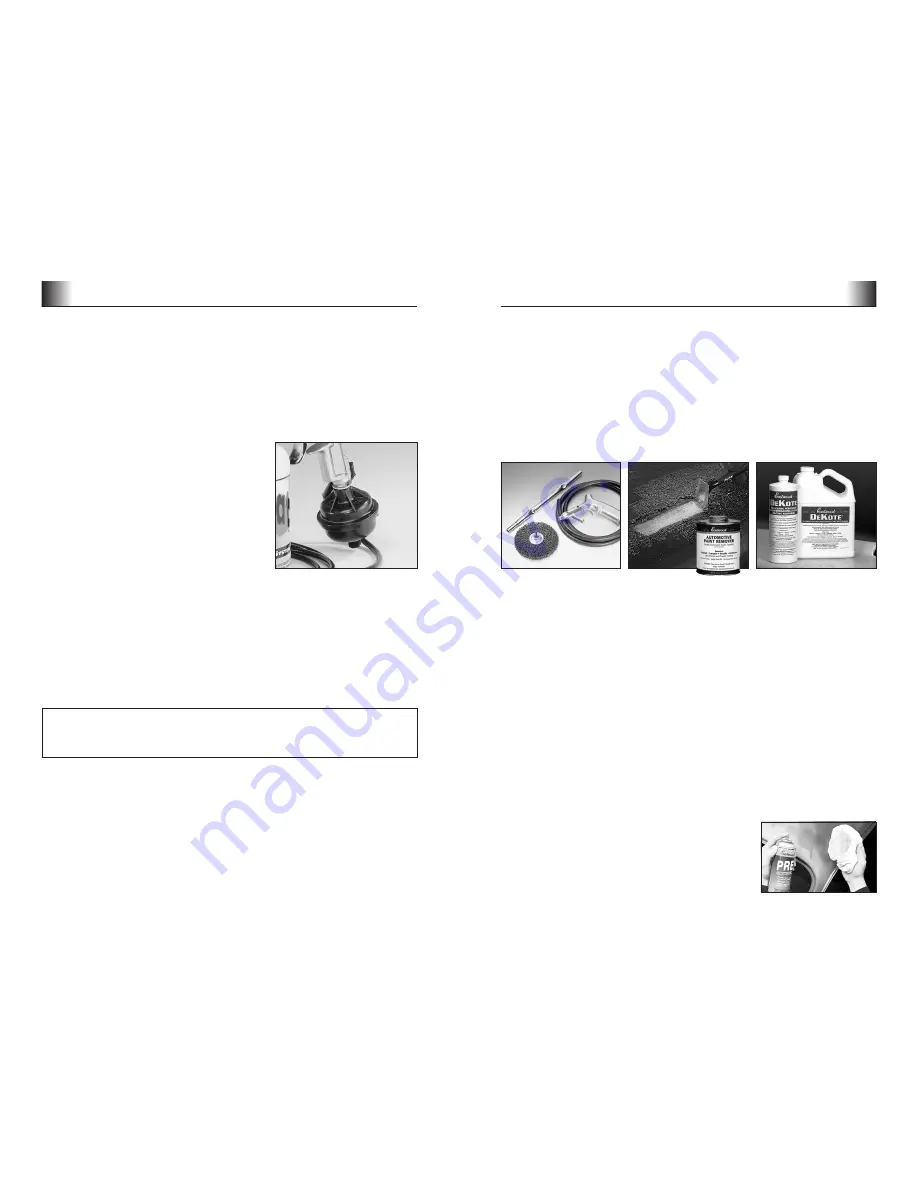
• A sheet of clean glossy paper or spoon for transferring powder
• A roll of aluminum foil
• A roll of
High Temperature Masking Tape 1/2” wide (#10027) or 1” wide
(#10115)
to mask bolts and other areas where powder build is not desired
(See
Masking the Part
, page 8)
•
High Temperature Silicone Plugs (set of 30, #10078)
to seal threaded
holes and close tolerance openings. These plugs also work great to support
parts in the oven during curing (See
Masking the Part
, page 8)
• A spool of
.041” Stainless Steel Safety Wire (#43045
) to hold parts while
powder coating and curing. It’s better to use clean wire than coated wire
to prevent contaminants from falling on to
the powdered surface
• Clean cotton rags or lint free paper towels
• An extra disposable
Moisture Separator
(#34066)
It should be replaced monthly
if used daily.
• A pair of leather heat-resistant gloves
• A quick disconnect air coupler
• A timer
• A tarp to collect powder dust for easy clean up
• A can of PRE Painting Prep (#10041Z). Apply
prior to powder coating and allow to air dry. Proper surface preparation is the
most important factor in achieving a durable finish
Other Available Products
Infrared Light Curing Systems (#10180 and #10680)
Used in place of an oven to cure items which have been powder coated.
Moisture Filter
(#43066)
Electrical sub-assemblies are not replaceable. If you damage any of the
electrical parts call Eastwood at 1-800-227-8321 and a Technical Representative
will gladly assist you in finding the best resolution to the problem.
I
TEMS
T
O
M
AKE
C
OATING
E
ASIER
6
For technical assistance e-mail: [email protected]
As with normal refinishing,
powder can only be applied to clean, bare metal
surfaces
. Properly clean the part to be coated by removing all traces of old
paint, rust, grease, oil, etc.
Removing Old Coatings
To chemically strip off old finishes use
Eastwood’s Paint and Powder Remover
Qt. (#10550ZP), Aer. (#11189Z)
or the environmentally-safe
Eastwood
DeKote
®
Qt. (#10410), Gal (#10411), Aer. (#10408Z).
To mechanically strip
the old finish use a
Cleaning Disc (#31095),
wire brush,
Radial Bristle Brush
(#31176),
Abrasive Blasting Gun (#22009)
or sand paper to completely
remove paint. Heavy paint coatings are often more efficiently removed by using
Paint Remover. If removing old powder coating, see page 16.
Chemical Rust Removal
Once the part is free of paint chemically remove the rust with
Eastwood’s
OxiSolv Rust Remover pint (#16025) , gallon (#16027), or 20 oz. spray
(#16026), and Eastwood OxiSolv Super Gel Gallon (#16028).
Dealing With Rust
Mechanical Rust Removal
Rust can be removed with a wire brush,
Cleaning Disc (#31095), Radial
Bristle Brush (#31176)
or by abrasive blasting. Eastwood has a wide variety
of abrasive blasting equipment, including our blast cabinets and
Blast out of a
Bucket Gun (#22009)
.
Metal-2-Metal Polyester Filler (#10021Z)
can be used as a filler for corroded
or pitted areas prior to powder. Apply
Metal-2-Metal
as you would any body
filler and finish by level sanding and feathering all edges with 180, 220, and 320
grit paper. Do not build filler more than 1/16” or lifting may occur during heat
cure. Filler applications should be pre baked at 400°F for 20 minutes before
final sanding and powder coating to assure against shrinkage. If you prefer a
single stage (non-catalyzed) filler, try
Lab Metal
24 oz. net wt. (#10207Z) or
Hi-Temp Lab Metal
24 oz. (10288Z).
Filling Minor Low Spots
Metal part must be free of any oil, dirt, or other
contaminants before powder coating. Clean with
Metal Wash (#10120)
,
PRE Painting Prep
(#10041Z), PRE Quarts (#10194ZP)
or acetone.
Grease and Oil Removal
P
REPARING
T
HE
P
ART
To order parts and supplies, call 1-800-345-1178 or www.eastwood.com
7
Abrasive Blast
Gun (#22009)
Cleaning Disc
(#31095)
Paint
Remover
DeKote



























